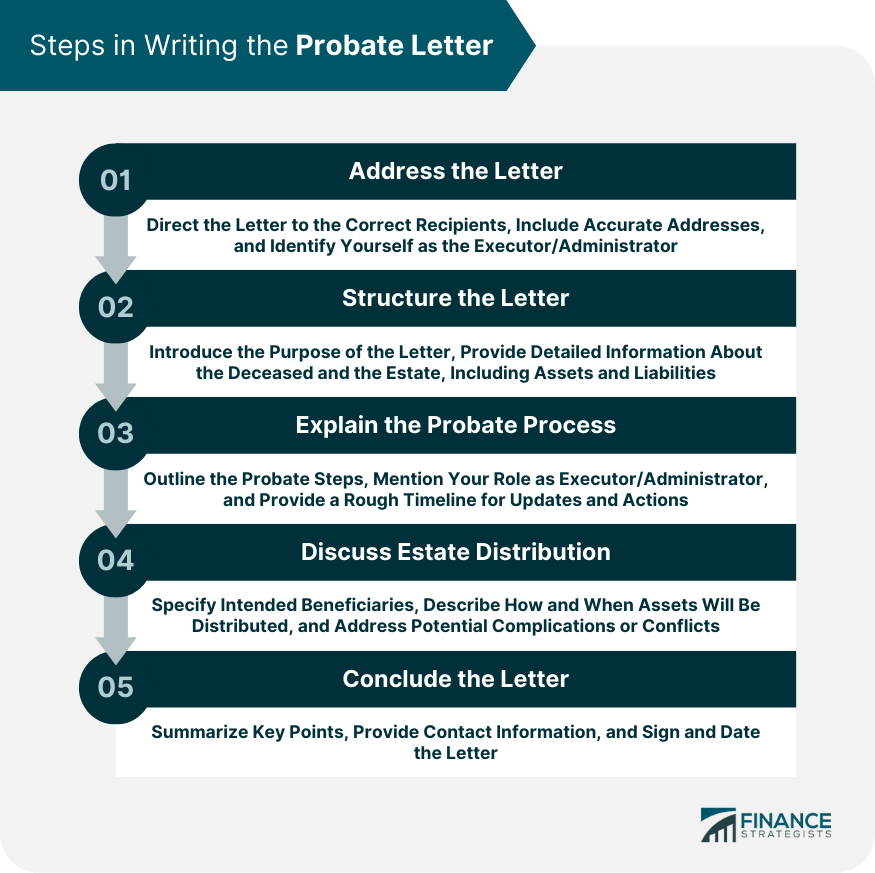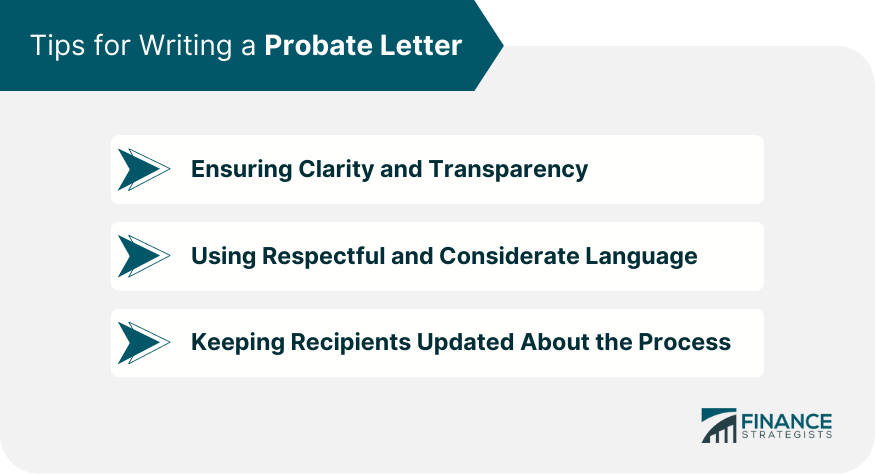A probate letter, or a letter of testamentary, is a crucial legal document used by an executor to display their authority to manage a deceased person's estate, granted by the probate court which oversees estate administration. This letter establishes transparent communication between the executor and all parties involved in the probate process, such as beneficiaries, debtors, and financial institutions. Additionally, it also provides essential information about the estate and validates the executor's authorization to manage its affairs. As you venture into writing a probate letter, it's crucial to understand some key probate terms. These include: Executor/Administrator: The individual appointed by the court to manage the deceased's estate. Beneficiary: The individual or entity who is entitled to receive assets from the deceased's estate. Probate Court: The court that supervises the process of validating a will and ensuring the equitable distribution of a deceased person's estate. Before drafting the letter, it is essential to gather all the necessary information and documents related to the deceased's estate. This will help you provide accurate details and demonstrate your authority to manage the estate effectively. Essential documents may include the deceased's will, a copy of the death certificate, and a court order appointing you as the executor or administrator. Understanding the deceased's estate is also crucial. This entails having a comprehensive understanding of the deceased's assets, liabilities, beneficiaries, and other relevant details. Gaining this understanding may involve conducting thorough research and possibly consulting with professionals such as estate lawyers or accountants. When addressing the letter, ensure that it is directed to the correct recipients, which might include beneficiaries, financial institutions, or creditors of the deceased. Their addresses should be accurate to ensure they receive the correspondence. It's also crucial to identify yourself and your role as the executor or administrator of the estate. The probate letter should begin with an introduction that outlines its purpose. This is typically to inform the recipient of the death and your appointment as the executor or administrator. Next, provide detailed information about the deceased. This could include their full name, date of death, and address. Also, mention any relevant details about the estate, such as the estimated value of the assets and the existence of any liabilities. The letter should outline the probate process to ensure the recipients understand what will happen next. Explain the steps you will take as the executor or administrator, and provide a rough timeline so the recipients know when to expect updates or actions. Provide details about the inheritance and who the intended beneficiaries are. Discuss how and when the assets will be distributed. If there are potential complications or conflicts, such as disputed wills or claims against the estate, address these in the letter as well. Conclude the letter by summarizing the key points discussed. This provides the recipients with a quick reference to the most important information. Also, provide your contact information, including your phone number, email address, and mailing address, in case the recipients have further queries. Finally, sign and date the letter. This attests to the truthfulness and accuracy of the information provided. Writing a probate letter involves a delicate balance of providing accurate and detailed information, communicating respectfully, and maintaining transparency. Use clear, straightforward language to ensure the recipients fully understand the content of the letter. Provide as much detail as necessary, but avoid overcomplicating things. Transparency is vital - ensure all parties involved understand the state of the estate, including assets, debts, and the intended distribution process. The probate process can be an emotional time for the deceased's loved ones. Always use respectful and considerate language. Acknowledge the difficulty of the situation and express your sympathies. Update recipients regularly. They will likely want to know how the process is progressing, particularly if they are beneficiaries. Regular updates can help keep the process transparent and avoid unnecessary confusion or conflict. As an executor or administrator, you have a fiduciary duty to manage the estate responsibly and in the best interest of the beneficiaries. You must ensure all debts and taxes are paid before distributing assets, and you must adhere to the instructions in the will (if one exists) or the intestacy laws of your state. Potential legal issues could arise if an executor or administrator mismanages the estate, fails to communicate effectively with beneficiaries, or does not adhere to the legal requirements of the probate process. To avoid these issues, it's crucial to stay organized, communicate effectively, and consult a legal professional if you are uncertain about any part of the process. The probate letter is an integral part of this communication and legal process. Understanding its purpose, structure, and legal implications is crucial for any executor or administrator. With these guidelines and examples, you'll be well-equipped to write a thorough and effective probate letter. Writing a probate letter requires a high degree of accuracy and professionalism. As an executor or administrator, you carry the responsibility of initiating the probate process and guiding other parties through it. Your letter serves as the foundation for this process, outlining your role, the estate's status, and the steps to follow. With careful preparation and clarity, you can draft a probate letter that effectively sets the stage for the probate process. The task of managing an estate can be demanding, but with the right resources and understanding, it can be done effectively. Don't hesitate to seek professional advice if needed. Remember, your primary role is to carry out the deceased's wishes and ensure their assets are appropriately distributed. Your probate letter is the first step towards fulfilling this significant responsibility.Overview of Probate Letter
Preparing to Write a Probate Letter
Writing the Probate Letter
Addressing the Letter
Structuring the Letter
Explaining the Probate Process
Discussing Estate Distribution
Conclusion of the Letter

Tips for Writing a Probate Letter
Ensuring Clarity and Transparency
Using Respectful and Considerate Language
Keeping Recipients Updated About the Process

Legal Implications of a Probate Letter
Understanding Legal Responsibilities as an Executor or Administrator
Potential Legal Issues and How to Avoid Them
The Bottom Line
How to Write a Probate Letter FAQs
A probate letter, or a letter of testamentary, is written to establish the executor's legal authority to manage the deceased's estate and to inform relevant parties about the probate process.
Start by gathering all necessary information and documents related to the deceased's estate. Then, structure your letter by addressing the recipient, explaining your role, detailing the estate, outlining the probate process, and discussing estate distribution.
Include your details, deceased's information, an outline of the probate process, information about the estate, and details about its distribution. Also, provide your contact information for any further queries.
Ensure clarity and transparency by using simple language, being respectful and considerate, and regularly updating the recipients about the process.
As an executor or administrator, you have a legal responsibility to manage the estate in the best interest of the beneficiaries. The probate letter demonstrates your authority and outlines your planned actions, which should comply with the law.
True Tamplin is a published author, public speaker, CEO of UpDigital, and founder of Finance Strategists.
True is a Certified Educator in Personal Finance (CEPF®), author of The Handy Financial Ratios Guide, a member of the Society for Advancing Business Editing and Writing, contributes to his financial education site, Finance Strategists, and has spoken to various financial communities such as the CFA Institute, as well as university students like his Alma mater, Biola University, where he received a bachelor of science in business and data analytics.
To learn more about True, visit his personal website or view his author profiles on Amazon, Nasdaq and Forbes.











